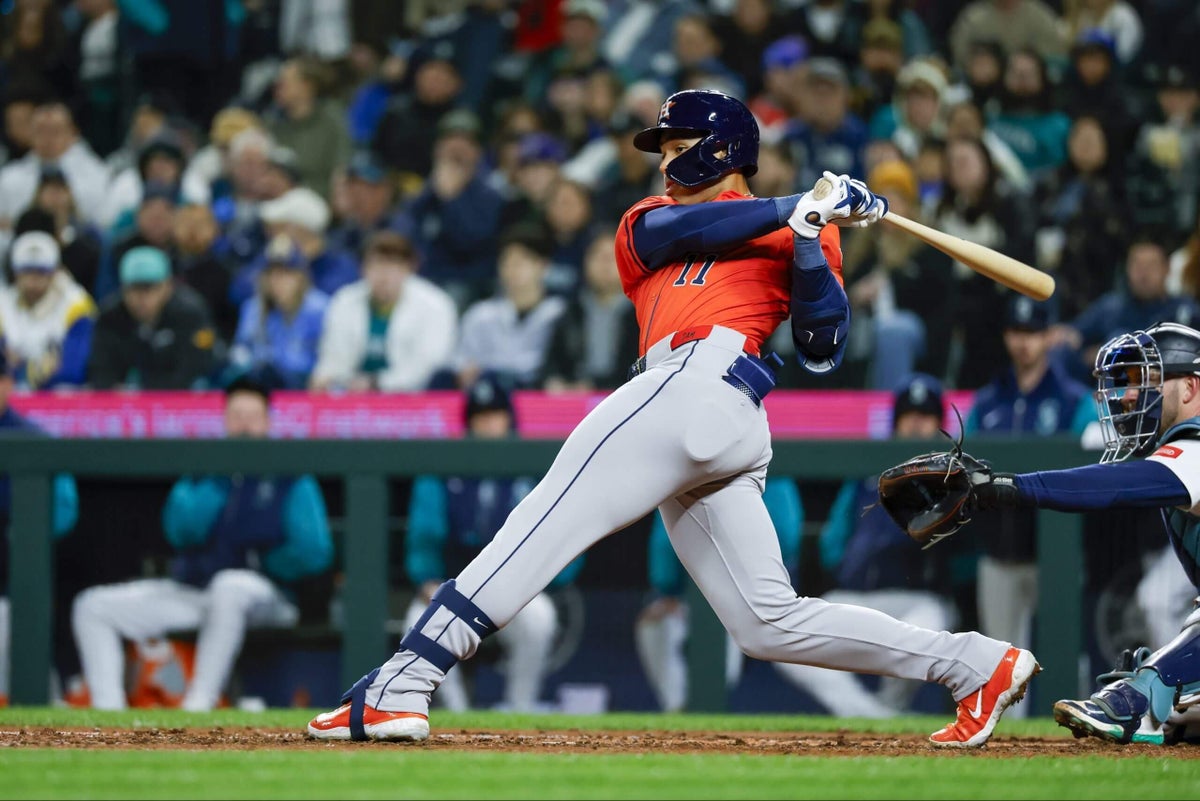SEATTLE — Five games into Cam Smith’s major-league career, Houston Astros coaches noticed something peculiar. Smith’s position in the batter’s box seemed farther away than at any point during his prolific spring training, leaving him susceptible to pitches thrown on the outer half.
Video analysis confirmed the club’s suspicions and sent the coaching staff into action. Manager Joe Espada sat Smith on Sunday and Monday in hopes some cage work could remedy the problem — one Smith himself said he hadn’t noticed.
During the discussions, hitting coaches Troy Snitker and Alex Cintrón encouraged Smith to get more into his legs and start his swing quicker, hoping the 22-year-old phenom could drive the baseball with more authority. Smith awoke Tuesday with a 66 percent ground-ball rate. None of his first nine batted balls were line drives, either.
“It’s a process,” Espada said after Tuesday’s game. “This kid is very talented. He’s grinding. He’s figuring stuff out.”
Putting a prospect with 134 professional plate appearances on a major-league roster requires patience. Development supersedes declarations made during spring training that Smith would be an everyday player.
Smith is supposed to be a stalwart for the next six seasons of Astros baseball, not someone thrust into April games to prove a point. Prioritizing his future is prudent, even if Houston has already hastened everything about Smith’s development.
Two days off to decompress and diagnose the deficiencies in Smith’s swing are more productive than pushing him to play through his struggles, when allowing their weight to mount could crater his confidence. It is a gamble Espada and his coaching staff could not risk for someone they want to play a pivotal role this season.
“I always remind him it’s a very long season and I want him to trust the process,” Espada said. “We got some really good coaches helping him, some really good veteran players helping him through stuff.”
Smith does not need to be a superstar. Others inside Houston’s clubhouse are tasked with that responsibility, but only one is performing to that level. Smith’s struggles are magnified as a result, inching the prospect toward a crossroads after just 24 major-league plate appearances.
After eking out a 2-1 win in 12 innings on Tuesday, the Astros have now scored two or fewer runs in six of their first 11 games. That the team is 5-6 is a credit to its pitching staff and, in this series, the atrocious Mariners lineup it is facing.
Seattle and Houston are the only two offenses in the sport with single-digit doubles. The Astros’ seven home runs are the second-fewest in baseball and no lineup has a lower slugging percentage than Houston’s .290 clip.
Smith is not the sole cause of Houston’s offensive anemia. Cleanup man Christian Walker struck out twice more on Tuesday before bouncing into a sixth-inning double play, prolonging a putrid beginning to his Astros career. Catcher Yainer Diaz has two hits in his first 33 at-bats. Neither Isaac Paredes nor Jeremy Peña has an OPS above .570.
Production by any or all of these players will lessen the focus on Smith, who is a more expendable piece of the 26-man roster than any of them.
Smith struck out in 10 of his first 21 major-league at-bats, the sort of failure he has never experienced. Even after slapping a run-scoring triple down the third-base line during Tuesday night’s win, Smith is still searching for continuity in a situation with few precedents.
CAM THE MAN!
1-0 Astros. pic.twitter.com/8QpTPf7KGc
— Houston Astros (@astros) April 9, 2025
“Obviously it’s not productive,” Smith said of his at-bats. “I know I’m an elite hitter, but I have to show that. Working with Cintrón and Snit, they’re helping me out along this process and I’ll get going.”
Treat the triple for what it is — an encouraging sign for someone who needed one. It snapped a 2-for-20 start to Smith’s season while crossing off two firsts.
Seeing Smith turn on a hanging sweeper and showcase his speed — he made it from home plate to third base in 11.53 seconds — showcased his tantalizing potential. Watching the two at-bats before it offered a reminder of how far he has to go.
Slotting Smith back in the starting lineup on Tuesday seemed sensible. Seattle starter Luis Castillo is a sinkerballer who pounds the inner half of a right-handed hitter’s strike zone, ideal after Smith’s positioning problems left him lunging for anything on the outer third.
Castillo abandoned that attack against Smith. Almost everything Smith saw from Castillo arrived on the outer half. After hearing — and agreeing with — pleas from Espada to be more aggressive early in counts, Smith fell behind 0-2 without taking a swing against Castillo in the third inning. He eventually waved through an elevated four-seamer.
Two frames later, Smith did swing at the first pitch he saw. The fastball, again on the outer half, flew by his barrel for strike one. Four pitches later, a late swing sent a sky-high popup to right field. It stranded the bases loaded, the sort of at-bat that somehow found Smith down in the eight-hole — and the type he’ll need to master if he wants to maintain his spot in a major-league lineup.
“This kid is going to be a good player,” Espada said. “I believe in him. It is going to take some time to get him going, but he’s doing the work that we’re asking him to do and he’s going to be just fine.”
(Photo: Joe Nicholson / Imagn Images)

